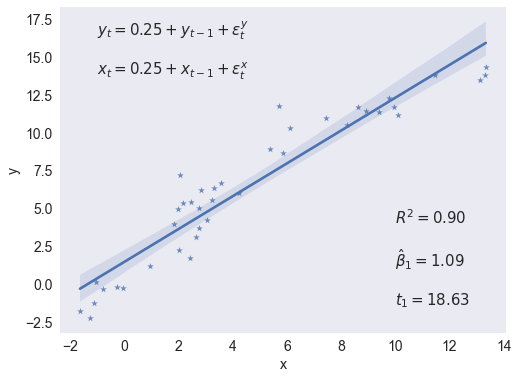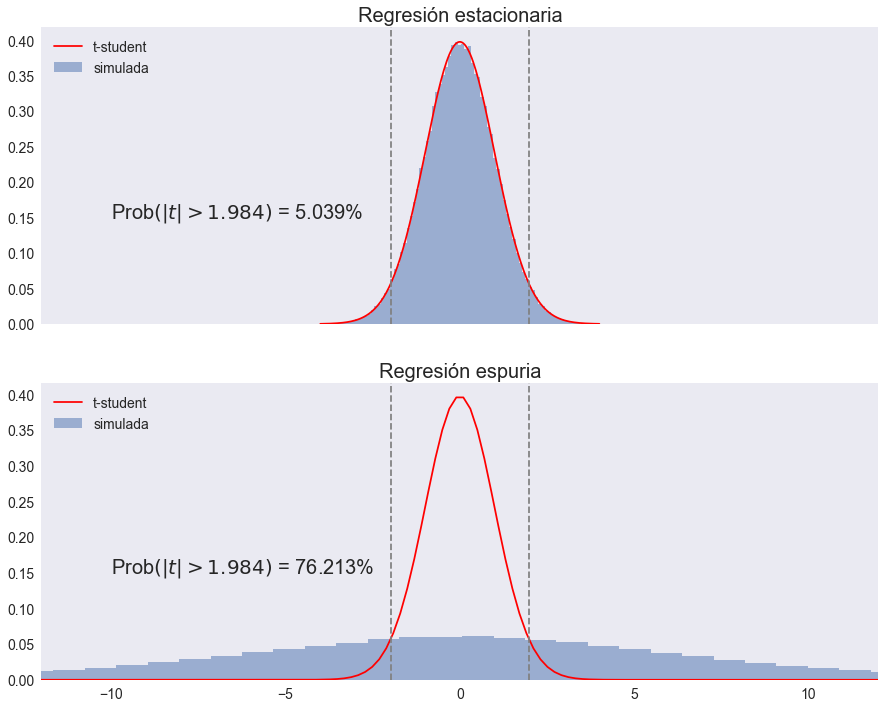Replicando el trabajo de Granger y Newbold 1974
Contents
4.2. Replicando el trabajo de Granger y Newbold 1974#
import numpy as np
import pandas as pd
import matplotlib.pyplot as plt
import statsmodels.api as sm
import seaborn as sns
from scipy.stats import t as t_Student
plt.style.use('seaborn')
plt.rc('figure', figsize=(15,4))
plt.rc('axes', titlesize=20, labelsize=14)
plt.rc('legend', fontsize=14)
plt.rc('xtick', labelsize=14)
plt.rc('ytick', labelsize=14)
from joblib import Parallel, delayed
def Monte_Carlo(funcion, repeticiones, columnas, *args, **kwargs):
"""
Ejecuta simulaciones de Montecarlo en paralelo, aprovechando todos los núcleos del procesador
Argumentos:
funcion: una función que dé por resultado una única realización de las cantidades que se desean simular
repeticiones: un entero que indica cuántas muestras se desean simular
columnas: una lista (o tupla) de strings, que identifiquen a las cantidades individuales retornadas por funcion
*args, **kwargs: otros parámetros requeridos por funcion
Retorna:
Un data frame de pandas, con tantas filas como `repeticiones` y columnas como textos en `columnas`.
"""
datos = Parallel(n_jobs=-1)(delayed(funcion)(*args, **kwargs) for _ in range(repeticiones))
return pd.DataFrame(datos, columns=columnas)
Regresión de una caminata aleatoria contra otra caminata aleatoria independiente#
np.random.seed(240)
e = np.random.randn(2,40)
y, x = (0.25+e).cumsum(axis=1)
X = sm.add_constant(x)
res = sm.OLS(y, X).fit()
fig, ax = plt.subplots(figsize=[8,6])
sns.regplot(x=x,y=y,marker='*',ax=ax)
ax.set(xlabel='x', ylabel='y')
statslabel = f'$R^2={res.rsquared:.2f}$'
statslabel += f'\n\n$\\hat\\beta_1={res.params[1]:.2f}$'
statslabel += f'\n\n$t_1={res.tvalues[1]:.2f}$'
ax.annotate(statslabel, (10,5), size=15, va='top')
modellabel = r'$y_t = 0.25 + y_{t-1} + \epsilon^y_t$'
modellabel += '\n\n$x_t = 0.25 + x_{t-1} + \\epsilon^x_t$'
ax.annotate(modellabel, (-1,17.5), size=15, va='top')
ax.grid(False)
fig.savefig('regresion-espuria-1caso.pdf', bbox_inches='tight')

res.params
array([1.44456189, 1.08570021])
np.linalg.solve(X.T @ X, X.T @ y)
array([1.44456189, 1.08570021])
Experimento de Monte Carlo para determinar la distribución del estadítico t#
def regresion_estacionaria(T=100):
y, x = np.random.randn(2,T)
X = sm.add_constant(x)
res = sm.OLS(y, X).fit()
return res.tvalues[1]
def regresion_espuria(T=100):
e = np.random.randn(2,T)
y, x = e.cumsum(axis=1)
X = sm.add_constant(x)
res = sm.OLS(y, X).fit()
return res.tvalues[1]
%%time
N = 100_000
np.random.seed(12345)
tvalues = Monte_Carlo(regresion_estacionaria, N,['t'])
np.random.seed(12345)
zvalues = Monte_Carlo(regresion_espuria, N, ['z'])
CPU times: total: 48.9 s
Wall time: 1min 35s
fig, (ax0,ax1) = plt.subplots(2,1,figsize=[15, 12], sharex=True)
maxtval = 12
t5crit = t_Student.isf(0.05/2, 98)
# regresión estacionaria
ff, edges = np.histogram(tvalues, bins=100, density=True)
center = (edges[1:] + edges[:-1])/2
w = center[1] - center[0]
ax0.bar(center, ff, width=w, alpha=0.5)
xvals = np.linspace(-4,4, 200)
ax0.plot(xvals, t_Student.pdf(xvals, df=98), '-r')
ax0.set(xlim=[-maxtval, maxtval], title='Regresión estacionaria')
ax0.legend(['t-student', 'simulada'], loc='upper left')
# regresión espuria
ff, edges = np.histogram(zvalues, bins=100, density=True)
center = (edges[1:] + edges[:-1])/2
w = center[1] - center[0]
ax1.bar(center, ff, width=w, alpha=0.5)
xvals = np.linspace(-20, 20, 200)
ax1.plot(xvals, t_Student.pdf(xvals, df=98), '-r')
ax1.set(xlim=[-maxtval,maxtval], title='Regresión espuria')
ax1.legend(['t-student', 'simulada'], loc='upper left')
# valores críticos
opciones = dict(ls="--", color='gray')
ax0.axvline(t5crit, **opciones)
ax0.axvline(-t5crit, **opciones)
ax1.axvline(t5crit, **opciones)
ax1.axvline(-t5crit, **opciones)
# error tipo I
err1 = (tvalues.abs() > t5crit).mean()*100
err1 = err1.iloc[0]
ax0.annotate(f'Prob$\\left(|t| > 1.984\\right)$ = {err1:.3f}%', (-10,0.15), size=20)
err1bad = (zvalues.abs() > t5crit).mean()*100
err1bad = err1bad.iloc[0]
ax1.annotate(f'Prob$\\left(|t| > 1.984\\right)$ = {err1bad:.3f}%', (-10,0.15), size=20)
ax0.grid(False)
ax1.grid(False)
fig.savefig('regresion-espuria.pdf', bbox_inches='tight')

NOTA Una versión anterior de este archivo incluía una simulación de la prueba de Dickey y Fuller. Ese código ahora aparece en el cuaderno DickeyFuller.ipynb.


